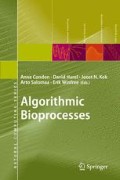Abstract
We present in this paper a novel molecular model for the gene regulatory network responsible for the eukaryotic heat shock response. Our model includes the temperature-induced protein misfolding, the chaperone activity of the heat shock proteins, and the backregulation of their gene transcription. We then build a mathematical model for it, based on ordinary differential equations. Finally, we discuss the parameter fit and the implications of the sensitivity analysis for our model.
Access this chapter
Tax calculation will be finalised at checkout
Purchases are for personal use only
Preview
Unable to display preview. Download preview PDF.
References
Alberts B, Johnson A, Lewis J, Raff M, Roberts K, Walter P (2004) Essential cell biology, 2nd edn. Garland Science, London
Burden RL, Douglas Faires J (1996) Numerical analysis. Thomson Brooks/Cole, Pacific Grove
Ciocca DR, Calderwood SK (2005) Heat shock proteins in cancer: diagnostic, prognostic, predictive, and treatment implications. Cell Stress Chaperones 10(2):86–103
El-Samad H, Kurata H, Doyle J, Gross CA, Khamash M (2005) Surviving heat shock: control strategies for robustness and performance. Proc Natl Acad Sci 102(8):2736–2741
El-Samad H, Prajna S, Papachristodoulu A, Khamash M, Doyle J (2003) Model validation and robust stability analysis of the bacterial heat shock response using sostools. In: Proceedings of the 42nd IEEE conference on decision and control, pp 3766–3741
Guldberg CM, Waage P (1864) Studies concerning affinity. In: Forhandlinger CM (ed) Videnskabs-Selskabet i Christiana, p. 35
Guldberg CM, Waage P (1879) Concerning chemical affinity. Erdmann’s J Pract Chem 127:69–114
Hoops S, Sahle S, Gauges R, Lee C, Pahle J, Simus N, Singhal M, Xu L, Mendes P, Kummer U (2006) Copasi—a complex pathway simulator. Bioinformatics 22(24):3067–3074
Kampinga HK (1993) Thermotolerance in mammalian cells: protein denaturation and aggregation, and stress proteins. J Cell Sci 104:11–17
Kline MP, Morimoto RI (1997) Repression of the heat shock factor 1 transcriptional activation domain is modulated by constitutive phosphorylation. Mol Cell Biol 17(4):2107–2115
Klipp E, Herwig R, Kowald A, Wierling C, Lehrach H (2006) Systems biology in practice. Wiley–VCH, New York
Kurata H, El-Samad H, Yi TM, Khamash M, Doyle J (2001) Feedback regulation of the heat shock response in e.coli. In: Proceedings of the 40th IEEE conference on decision and control, pp 837–842
Lepock JR, Frey HE, Ritchie KP (1993) Protein denaturation in intact hepatocytes and isolated cellular organelles during heat shock. J Cell Biol 122(6):1267–1276
Lepock JR, Frey HE, Rodahl AM, Kruuv J (1988) Thermal analysis of chl v79 cells using differential scanning calorimetry: Implications for hyperthermic cell killing and the heat shock response. J Cell Physiol 137(1):14–24
Liu B, DeFilippo AM, Li Z (2002) Overcomming immune tolerance to cancer by heat shock protein vaccines. Mol Cancer Ther 1:1147–1151
Lukacs KV, Pardo OE, Colston MJ, Geddes DM, Alton EWFW (2000) Heat shock proteins in cancer therapy. In: Habib (ed) Cancer gene therapy: past achievements and future challenges. Kluwer, Dordrecht, pp 363–368
Nelson DL, Cox MM (2000) Principles of biochemistry, 3rd edn. Worth Publishers, New York
Peper A, Grimbergent CA, Spaan JAE, Souren JEM, van Wijk R (1997) A mathematical model of the hsp70 regulation in the cell. Int J Hyperthermia 14:97–124
Petre I, Hyder CL, Mizera A, Mikhailov A, Eriksson JE, Sistonen L, Back R-J (2008) Two metabolites are enough to drive the eukaryotic heat shock response. Manuscript
Pockley AG (2003) Heat shock proteins as regulators of the immune response. Lancet 362(9382):469–476
Press WH, Teukolsky SA, Vetterling WT, Flammery BP (2007) Numerical recipes: the art of scientific computing. Cambridge University Press, Cambridge
Rieger TR, Morimoto RI, Hatzimanikatis V (2005) Mathematical modeling of the eukaryotic heat shock response: dynamics of the hsp70 promoter. Biophys J 88(3):1646–1658
Srivastava R, Peterson MS, Bentley WE (2001) Stochastic kinetic analysis of the escherichia coli stres circuit using σ 32-targeted antisense. Biotechnol Bioeng 75(1):120–129
Taubes CH (2001) Modeling differential equations in biology. Cambridge University Press, Cambridge
Tomlin CJ, Axelrod JD (2005) Understanding biology by reverse engineering the control. Proc Natl Acad Sci 102(12):4219–4220
Turányi T (1990) Sensitivity analysis of complex kinetic systems. Tools and applications. J Math Chem 5:203–248
Workman P, de Billy E (2007) Putting the heat on cancer. Nat Med 13(12):1415–1417
Zill DG (2001) A first course in differential equations. Thomson, Tompa
Zill DG (2005) A first course in differential equations with modeling applications. Thomson, Tompa
Author information
Authors and Affiliations
Corresponding author
Editor information
Editors and Affiliations
Rights and permissions
Copyright information
© 2009 Springer-Verlag Berlin Heidelberg
About this chapter
Cite this chapter
Petre, I. et al. (2009). A New Mathematical Model for the Heat Shock Response. In: Condon, A., Harel, D., Kok, J., Salomaa, A., Winfree, E. (eds) Algorithmic Bioprocesses. Natural Computing Series. Springer, Berlin, Heidelberg. https://doi.org/10.1007/978-3-540-88869-7_21
Download citation
DOI: https://doi.org/10.1007/978-3-540-88869-7_21
Published:
Publisher Name: Springer, Berlin, Heidelberg
Print ISBN: 978-3-540-88868-0
Online ISBN: 978-3-540-88869-7
eBook Packages: Computer ScienceComputer Science (R0)

